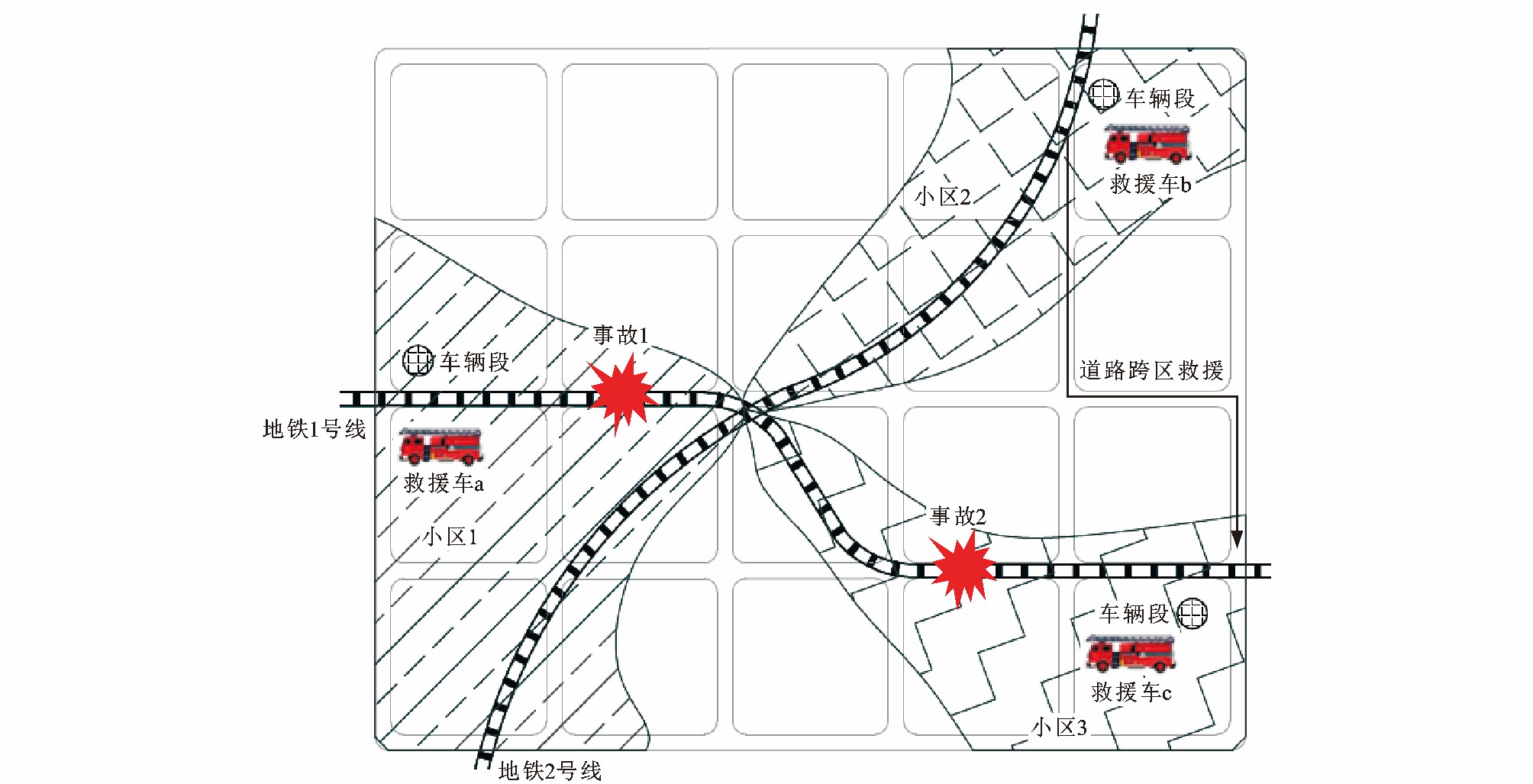Evaluating model of deployment performance of metro emergency rescue vehicles
-
摘要: 分析了地铁应急救援车辆对地铁灾害事故实施救援的排队过程, 定义了救援车辆响应地铁灾害事故的状态空间, 基于随机生灭过程理论建立了救援车辆的联合排队模型, 得到救援状态平衡方程; 为了减小平衡方程求解的运算量与存储空间, 提出了基于稀疏矩阵压缩的联合排队状态概率改进求解算法, 给出了包括救援响应时间、救援车辆工作强度、跨区救援概率等地铁救援系统各项绩效评价指标计算方法; 为了验证模型与求解算法, 以实际的地铁线网为例, 研究了路轨两用救援车、履带式救援车和便携式救援车的性能指标。计算结果表明: 算法迭代7次以后, 收敛精度数量级达到了10-8; 路轨两用救援车、履带式救援车和便携式救援车的平均响应时间分别约为14、20、10 min; 路轨两用救援车、履带式救援车跨区救援概率分别约为0.85、0.75, 便携式救援车跨区救援概率数量级为10-5; 在各小区接收外部救援车方面, 路轨两用救援车和履带式救援车跨区救援概率约为0.7, 而便携式救援车跨区救援概率的数量级约为10-6; 在救援强度的均衡性方面, 路轨两用救援车、履带式救援车和便携式救援车依次降低。Abstract: The rescue operation queue process of metro emergency rescue vehicles (MERVs) responding to metro disasters was analyzed. By defining the state space of MERVs in response to metro disasters, the joint queuing model of MERVs' rescue states was established based on the random birth-death process theory and obtained balance equations. In order to reduce the computation amount and storage space of balance equations, an improved solving algorithm of joint queuing state probability based on the sparse matrix compression was developed. The calculation methods of various performance evaluation indexes of metro rescue system, including the rescue response time, MERVs working intensity and cross-district rescue probability, were given. In order to verify the model and algorithm, the actual metro network was taken as an example, and the performance indexes of three types of MERVs, including the road-rail rescue vehicle, crawler rescue vehicle and portable rescue vehicle, were studied. Calculation result shows that the magnitude of convergence precision reaches 10-8 after the algorithm iterates 7 times. The average response times of road-rail rescue vehicle, crawler rescue vehicle and portable rescue vehicle are about 14, 20 and 10 min, respectively. The cross-district rescue probabilities of road-rail rescue vehicle and crawler rescue vehicle are about 0.85 and 0.75, respectively, and the magnitude of portable rescue vehicle is 10-5. For the regions receiving external rescues, the rescue probabilities of road-rail rescue vehicle and crawler rescue vehicle both are about 0.7, while the magnitude of portable rescue vehicle is about 10-6. For the balance of rescue intensity, they are sequentially decline the road-rail rescue vehicle, crawler rescue vehicle and portable rescue vehicle.
-
表 1 救援车辆配置
Table 1. Deployment of rescue vehicles veh
线路 小区 车型数量 路轨两用救援车 履带式救援车 便携式救援车 1号线 1 0 2 1 2 0 0 2 3 0 0 3 4 0 0 2 5 1 2 2 5号线 6 0 2 2 7 0 0 2 8 0 0 3 9 0 0 2 10 1 2 1 表 2 2007~2014年北京市地铁救援次数与时间
Table 2. Railway rescue times and time of Beijing during 2007-2014
年份 每年救援次数 平均救援时间/min 1号线 5号线 2007 2 2 23.0 2008 2 1 24.7 2009 2 1 47.5 2010 2 1 30.0 2011 3 0 16.3 2012 2 0 18.8 2013 0 2 20.0 2014 5 2 13.8 表 3 路轨两用救援车和履带式救援车在小区间的行程时间
Table 3. Travel times of road-rail rescue vehicles and crawler rescue vehicles between zones h
小区 1 2 3 4 5 6 7 8 9 10 1 0.08 0.18 0.34 0.48 0.61 0.99 1.14 1.29 1.14 1.02 2 0.18 0.10 0.17 0.30 0.44 0.99 1.14 1.46 1.31 1.20 3 0.34 0.17 0.07 0.14 0.27 0.82 0.97 1.27 1.24 1.13 4 0.48 0.30 0.14 0.06 0.13 0.69 0.84 1.13 1.11 1.00 5 0.61 0.44 0.27 0.13 0.07 0.55 0.70 1.00 0.98 0.86 6 0.99 0.99 0.82 0.69 0.55 0.08 0.15 0.23 0.45 0.56 7 1.14 1.14 0.97 0.84 0.70 0.15 0.07 0.15 0.30 0.41 8 1.29 1.46 1.27 1.13 1.00 0.23 0.15 0.08 0.15 0.19 9 1.14 1.31 1.24 1.11 0.98 0.45 0.30 0.15 0.07 0.11 10 1.02 1.20 1.13 1.00 0.86 0.56 0.41 0.19 0.11 0.04 表 4 便携式救援车在小区间的行程时间
Table 4. Travel times of portable rescue vehicles between zones h
小区 1 2 3 4 5 6 7 8 9 10 1 0.19 0.44 0.86 1.19 1.53 0.99 1.14 1.29 1.14 1.02 2 0.44 0.24 0.42 0.76 1.09 0.99 1.14 1.46 1.31 1.20 3 0.86 0.42 0.18 0.34 0.67 0.82 0.97 1.27 1.24 1.13 4 1.19 0.76 0.34 0.16 0.33 0.69 0.84 1.13 1.11 1.00 5 1.53 1.09 0.67 0.33 0.18 0.55 0.70 1.00 0.98 0.86 6 0.99 0.99 0.82 0.69 0.55 0.21 0.38 0.58 1.12 1.40 7 1.14 1.14 0.97 0.84 0.70 0.38 0.17 0.37 0.74 1.03 8 1.29 1.46 1.27 1.13 1.00 0.58 0.37 0.20 0.38 0.48 9 1.14 1.31 1.24 1.11 0.98 1.12 0.74 0.38 0.18 0.28 10 1.02 1.20 1.13 1.00 0.86 1.40 1.03 0.48 0.28 0.11 -
[1] OKUMURA T, SUZUKI K, FUKUDA A, et al. The Tokyo subway sarin attack: disaster management, Part 1: community emergency response[J]. Academic Emergency Medicine, 1998, 5 (6): 613-617. doi: 10.1111/j.1553-2712.1998.tb02470.x [2] OKUMURA T, SUZUKI K, FUKUDA A, et al. The Tokyo subway sarin attack: disaster management, Part 2: hospital response[J]. Academic Emergency Medicine, 1998, 5 (6): 618-624. doi: 10.1111/j.1553-2712.1998.tb02471.x [3] CHOI N. Narrative analysis on survivor's experience of Daegu subway fire disaster—the hypothetical suggestions for disaster nursing practice[J]. Journal of Korean Academy of Nursing, 2005, 35 (2): 407-418. doi: 10.4040/jkan.2005.35.2.407 [4] ZHONG Mao-hua, SHI Cong-ling, TU Xu-wei, et al. Study of the human evacuation simulation of metro fire safety analysis in China[J]. Journal of Loss Prevention in the Process Industries, 2008, 21 (3): 287-298. doi: 10.1016/j.jlp.2007.08.001 [5] CHEN Fa-lin, GUO Shin-chang, CHUAY He-yuan, et al. Smoke control of fires in subway stations[J]. Theoretical and Computational Fluid Dynamics, 2003, 16: 349-368. doi: 10.1007/s00162-002-0086-5 [6] GAO Ran, LI An-gui, HAO Xin-peng, et al. Fire-induced smoke control via hybrid ventilation in a huge transit terminal subway station[J]. Energy and Buildings, 2012, 45: 280-289. doi: 10.1016/j.enbuild.2011.11.018 [7] ROH J S, RYOU H S, YOON S W. The effect of PSD on life safety in subway station fire[J]. Journal of Mechanical Science and Technology, 2010, 24 (4): 937-942. doi: 10.1007/s12206-010-0217-7 [8] MENG Na, HU Long-hua, WU Long, et al. Numerical study on the optimization of smoke ventilation mode at the conjunction area between tunnel track and platform in emergency of a train fire at subway station[J]. Tunnelling and Underground Space Technology, 2014, 40: 151-159. doi: 10.1016/j.tust.2013.09.014 [9] YOON S H, LEE M J, YEE J J. An experimental study on evacuation times in a subway station using evacuation parameters[J]. Journal of Asian Architecture and Building Engineering, 2013, 12 (1): 93-100. doi: 10.3130/jaabe.12.93 [10] JEON G, HONG W. Characteristic features of the behavior and perception of evacuees from the Daegu subway fire and safety measures in an underground fire[J]. Journal of Asian Architecture and Building Engineering, 2009, 8 (2): 415-422. doi: 10.3130/jaabe.8.415 [11] QU L, CHOW W. Platform screen doors on emergency evacuation in underground railway stations[J]. Tunnelling and Underground Space Technology, 2012, 30: 1-9. doi: 10.1016/j.tust.2011.09.003 [12] WAN Jia-hui, SUI Jie, YU Hua. Research on evacuation in the subway station in China based on the combined social force model[J]. Physica A: Statistical Mechanics and its Applications, 2014, 394: 33-46. doi: 10.1016/j.physa.2013.09.060 [13] ZHAO Hai-feng, JIANG Jie, XU Rong-yu, et al. SIRS model of passengers' panic propagation under self-organization circumstance in the subway emergency[J]. Mathematical Problems in Engineering, 2014, 2014: 1-12. [14] SHVETSOV A, SHVETSOVA S, KOZYREV V A, et al. The "car-bomb" as a terrorist tool at metro stations, railway terminals and airports[J]. Journal of Transportation Security, 2017, 10 (1/2): 31-43. [15] SHVETSOV A V, SHAROV V A, KOZYREV V A, et al. Trends of modern terrorism in the metro systems of the world[J]. European Journal for Security Research, 2018, 6 (3): 1-8. [16] HAKIMI S L. Optimum locations of switching centers and the absolute centers and medians of a graph[J]. Operations Research, 1964, 12 (3): 450-459. doi: 10.1287/opre.12.3.450 [17] CALVO A B, MARKS D H. Location of health care facilities: an analytical approach[J]. Socio-Economic Planning Sciences, 1973, 7: 407-422. doi: 10.1016/0038-0121(73)90039-6 [18] CARBONE R. Public facility location under stochastic demand[J]. INFOR Journal, 1974, 12 (3): 261-270. [19] CARSON Y M, BATTA R. Locating an ambulance on the Amherst Campus of the State University of New York at Buffalo[J]. Interfaces, 1990, 20 (5): 43-49. doi: 10.1287/inte.20.5.43 [20] SNYDER L V. Facility Location under uncertainty: a review[J]. IIE Transactions, 2006, 38: 537-554. doi: 10.1080/074081791009022 [21] DASKIN M S. A maximum expected covering location model: formulation, properties and heuristic solution[J]. Transportation Science, 1983, 17 (1): 48-70. doi: 10.1287/trsc.17.1.48 [22] HOGAN K, REVELLE C. Concepts and applications of backup coverage[J]. Management Science, 1986, 32 (11): 1434-1444. doi: 10.1287/mnsc.32.11.1434 [23] REPEDE J F, BERNARDO J J. Developing and validating a decision support system for locating emergency medical vehicles in Louisville, Kentucky[J]. European Journal of Operational Research, 1994, 75: 567-581. doi: 10.1016/0377-2217(94)90297-6 [24] GOLDBERG J B. Operations research models for the deployment of emergency services vehicles[J]. EMS Management Journal, 2004, 1 (1): 20-39. [25] 吴艳华, 王富章, 李芳. 铁路救援基地层级规划选址模型[J]. 交通运输工程学报, 2013, 13 (3): 86-93. http://transport.chd.edu.cn/article/id/201303012WU Yan-hua, WANG Fu-zhang, LI Fang. Hierarchical planning location model of railway rescue center[J]. Journal of Traffic and Transportation Engineering, 2013, 13 (3): 86-93. (in Chinese). http://transport.chd.edu.cn/article/id/201303012 [26] ARINGHIERI R, BRUNI M E, KHODAPARASTI S, et al. Emergency medical services and beyond: addressing new challenges through a wide literature review[J]. Computers and Operations Research, 2017, 78: 349-368. doi: 10.1016/j.cor.2016.09.016 [27] BÉLANGER V, RUIZ A, SORIANO P. Recent optimization models and trends in location, relocation, and dispatching of emergency medical vehicles[J]. European Journal of Operational Research, 2019, 272 (1): 1-23. -





 下载:
下载:













